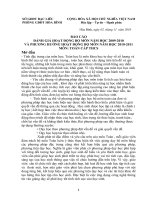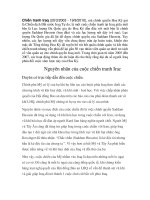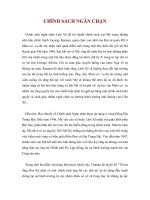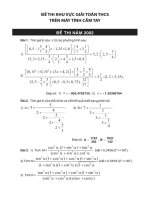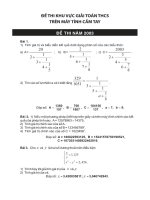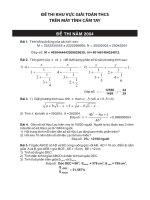ups and downs grade 8 Bộ Sách Toán THCS Của Mỹ
Bạn đang xem bản rút gọn của tài liệu. Xem và tải ngay bản đầy đủ của tài liệu tại đây (3.16 MB, 64 trang )
Ups and
Downs
Algebra
CuuDuongThanCong.com
/>
Mathematics in Context is a comprehensive curriculum for the middle grades.
It was developed in 1991 through 1997 in collaboration with the Wisconsin Center
for Education Research, School of Education, University of Wisconsin-Madison and
the Freudenthal Institute at the University of Utrecht, The Netherlands, with the
support of the National Science Foundation Grant No. 9054928.
The revision of the curriculum was carried out in 2003 through 2005, with the
support of the National Science Foundation Grant No. ESI 0137414.
National Science Foundation
Opinions expressed are those of the authors
and not necessarily those of the Foundation.
Abels, M.; de Jong, J. A.; Dekker, T.; Meyer, M. R.; Shew, J. A.; Burrill, G.; and
Simon, A. N. (2006). Ups and downs. In Wisconsin Center for Education Research
& Freudenthal Institute (Eds.), Mathematics in Context. Chicago: Encyclopædia
Britannica, Inc.
Copyright © 2006 Encyclopædia Britannica, Inc.
All rights reserved.
Printed in the United States of America.
This work is protected under current U.S. copyright laws, and the performance,
display, and other applicable uses of it are governed by those laws. Any uses not
in conformity with the U.S. copyright statute are prohibited without our express
written permission, including but not limited to duplication, adaptation, and
transmission by television or other devices or processes. For more information
regarding a license, write Encyclopædia Britannica, Inc., 331 North LaSalle Street,
Chicago, Illinois 60610.
ISBN 0-03-038576-8
3 4 5 6 073 09 08 07 06
CuuDuongThanCong.com
/>
The Mathematics in Context Development Team
Development 1991–1997
The initial version of Ups and Downs was developed by Mieke Abels and Jan Auke de Jong.
It was adapted for use in American schools by Margaret R. Meyer, Julia A. Shew, Gail Burrill,
and Aaron N. Simon.
Wisconsin Center for Education
Freudenthal Institute Staff
Research Staff
Thomas A. Romberg
Joan Daniels Pedro
Jan de Lange
Director
Assistant to the Director
Director
Gail Burrill
Margaret R. Meyer
Els Feijs
Martin van Reeuwijk
Coordinator
Coordinator
Coordinator
Coordinator
Sherian Foster
James A, Middleton
Jasmina Milinkovic
Margaret A. Pligge
Mary C. Shafer
Julia A. Shew
Aaron N. Simon
Marvin Smith
Stephanie Z. Smith
Mary S. Spence
Mieke Abels
Jansie Niehaus
Nina Boswinkel
Nanda Querelle
Frans van Galen
Anton Roodhardt
Koeno Gravemeijer
Leen Streefland
Marja van den Heuvel-Panhuizen
Jan Auke de Jong
Adri Treffers
Vincent Jonker
Monica Wijers
Ronald Keijzer
Astrid de Wild
Martin Kindt
Project Staff
Jonathan Brendefur
Laura Brinker
James Browne
Jack Burrill
Rose Byrd
Peter Christiansen
Barbara Clarke
Doug Clarke
Beth R. Cole
Fae Dremock
Mary Ann Fix
Revision 2003–2005
The revised version of Ups and Downs was developed by Truus Dekker and Mieke Abels.
It was adapted for use in American schools by Gail Burrill.
Wisconsin Center for Education
Freudenthal Institute Staff
Research Staff
Thomas A. Romberg
David C. Webb
Jan de Lange
Truus Dekker
Director
Coordinator
Director
Coordinator
Gail Burrill
Margaret A. Pligge
Mieke Abels
Monica Wijers
Editorial Coordinator
Editorial Coordinator
Content Coordinator
Content Coordinator
Margaret R. Meyer
Anne Park
Bryna Rappaport
Kathleen A. Steele
Ana C. Stephens
Candace Ulmer
Jill Vettrus
Arthur Bakker
Peter Boon
Els Feijs
Dédé de Haan
Martin Kindt
Nathalie Kuijpers
Huub Nilwik
Sonia Palha
Nanda Querelle
Martin van Reeuwijk
Project Staff
Sarah Ailts
Beth R. Cole
Erin Hazlett
Teri Hedges
Karen Hoiberg
Carrie Johnson
Jean Krusi
Elaine McGrath
CuuDuongThanCong.com
/>
(c) 2006 Encyclopædia Britannica, Inc. Mathematics in Context
and the Mathematics in Context Logo are registered trademarks
of Encyclopædia Britannica, Inc.
Cover photo credits: (left to right) © William Whitehurst/Corbis;
© Getty Images; © Comstock Images
Illustrations
1, 13 Holly Cooper-Olds; 18, 19 (bottom), 22 Megan Abrams/
© Encyclopædia Britannica, Inc.; 35 Holly Cooper-Olds
Photographs
4 Sam Dudgeon/HRW; 7 (middle left) © PhotoDisc/Getty Images; (middle
right) © Jack Hollingsworth/PhotoDisc/Getty Images; (bottom) © Corbis;
8 © ImageState; 14 © Stephanie Pilick/AFP/Getty Images; 17 Stephanie
Friedman/HRW; 27 John Bortniak, NOAA; 29 © Kenneth Mantai/Visuals
Unlimited; 31 (top) Peter Van Steen/HRW Photo; (bottom) CDC; 37 © Corbis;
38 Dynamic Graphics Group/Creatas/Alamy; 39 © Corbis; 43 Victoria
Smith/HRW; 44 Sam Dudgeon/HRW Photo; 48 (left to right) © Corbis;
© Digital Vision/Getty Images
CuuDuongThanCong.com
/>
Contents
Letter to the Student
vi
1914
1913
Wooden Graphs
Totem Pole
Growing Up
Growth Charts
Water for the Desert
Sunflowers
Summary
Check Your Work
Section B
1910
25
15
5
1910
1911
1912
1913
1914
Year
13
15
17
18
20
21
23
24
27
29
30
32
33
Cycles
Fishing
High Tide, Low Tide
Golden Gate Bridge
The Air Conditioner
Blood Pressure
The Racetrack
Summary
Check Your Work
Section E
1
3
4
6
7
8
10
11
Differences in Growth
Leaf Area
Area Differences
Water Lily
Aquatic Weeds
Double Trouble
Summary
Check Your Work
Section D
1911
Linear Patterns
The Marathon
What’s Next?
Hair and Nails
Renting a Motorcycle
Summary
Check Your Work
Section C
1912
Trendy Graphs
Ring Thickness
( in mm)
Section A
35
36
37
38
38
39
40
40
Half and Half Again
Fifty Percent Off
Medicine
Summary
Check Your Work
43
44
46
46
Additional Practice
47
Answers to Check Your Work
52
Contents v
CuuDuongThanCong.com
/>
Dear Student,
Welcome to Ups and Downs. In this unit, you will look at situations
that change over time, such as blood pressure or the tides of an
ocean. You will learn to represent these changes using tables,
graphs, and formulas.
Graphs of temperatures and tides show up-and-down movement,
but some graphs, such as graphs for tree growth or melting ice,
show only upward or only downward movement.
As you become more familiar with graphs and the changes that
they represent, you will begin to notice and understand graphs
in newspapers, magazines, and advertisements.
During the next few weeks, look for graphs and statements about
growth, such as “Fast-growing waterweeds in lakes become a
problem.” Bring to class interesting graphs and newspaper articles
and discuss them.
Telling a story with a graph can help you understand the story.
Sincerely,
The Mathematics in Context Development Team
April 20
+80
+60
Water Level
+40
(in cm)
+20
Sea Level 0
-20
-40
-60
-80
-100
Time
1
A.M.
3
5
7
9 11 1
3
5
7
9 11
P.M.
vi Ups and Downs
CuuDuongThanCong.com
/>
A
Trendy Graphs
Wooden Graphs
Giant sequoia trees grow in Sequoia National Park in California.
The largest tree in the park is thought to be between 3,000 and
4,000 years old.
It takes 16 children holding hands
to reach around the giant sequoia
shown here.
1. Find a way to estimate
the circumference and
diameter of this tree.
This is a drawing of a cross section of a tree. Notice
its distinct ring pattern. The bark is the dark part on
the outside. During each year of growth, a new layer
of cells is added to the older wood. Each layer forms
a ring. The distance between the dark rings shows
how much the tree grew that year.
2. Look at the cross section of the tree. Estimate the
age of this tree. How did you find your answer?
Take a closer look at the cross section. The picture
below the cross section shows a magnified portion.
3. a. Looking at the magnified portion, how can
you tell that this tree did not grow the same
amount each year?
b. Reflect What are some possible reasons for
the tree’s uneven growth?
Section A: Trendy Graphs 1
CuuDuongThanCong.com
/>
A Trendy Graphs
Tree growth is directly related to the amount of moisture supplied. Look
at the cross section on page 1 again. Notice that one of the rings is very
narrow.
4. a. What conclusion can you draw about the rainfall during the
year that produced the narrow ring?
b. How old was the tree that year?
The oldest known living tree is a bristlecone pine (Pinus aristata)
named Methuselah. Methuselah is about 4,700 years old and grows
in the White Mountains of California.
It isn’t necessary to cut down a tree in order to
examine the pattern of rings. Scientists use a
technique called coring to take a look at the
rings of a living tree. They use a special drill to
remove a piece of wood from the center of the
tree. This piece of wood is about the thickness
of a drinking straw and is called a core sample.
The growth rings show up as lines on the core
sample.
By matching the ring patterns from a living tree
with those of ancient trees, scientists can create
a calendar of tree growth in a certain area.
The picture below shows how two core samples
are matched up. Core sample B is from a living
tree. Core sample A is from a tree that was
cut down in the same area. Matching the two
samples in this way produces a “calendar” of
wood.
A
1990
1980
1970
1960
B
5. In what year was the tree represented by
core sample A cut down?
2 Ups and Downs
CuuDuongThanCong.com
/>
Trendy Graphs A
The next picture shows a core sample from another tree that was
cut down. If you match this one to the other samples, the calendar
becomes even longer. Enlarged versions of the three strips can be
found on Student Activity Sheet 1.
C
6. What period of time is represented by the three core samples?
1914
Instead of working with the actual
core samples or drawings of core
samples, scientists transfer the
information from the core samples
onto a diagram like this one.
1913
1912
1911
1910
Ring Thickness
( in mm)
7. About how thick was the ring
in 1910?
25
15
5
1910
1911
1912
1913
1914
Year
Totem Pole
Tracy found a totem pole in the woods behind her house. It had fallen
over, so Tracy could see the growth rings on the bottom of the pole.
She wondered when the tree from which it was made was cut down.
Section A: Trendy Graphs 3
CuuDuongThanCong.com
/>
A Trendy Graphs
Thickness of Rings
(in mm)
Tracy asked her friend Luis, who studies plants and trees in college, if
he could help her find the age of the wood. He gave her the diagram
pictured below, which shows how cedar trees that were used to make
totem poles grew in their area.
20
15
10
5
1915
1920
1940
1930
Year
8. a. Make a similar diagram of the thickness of the rings of the
totem pole that Tracy found.
b. Using the diagram above, can you find the age of the totem
pole? What year was the tree cut down?
Growing Up
On Marsha’s birthday, her father marked her
height on her bedroom door. He did this
every year from her first birthday until she
was 19 years old.
9. There are only 16 marks. Can you
explain this?
10. How old was Marsha when her growth
slowed considerably?
11. Where would you put a mark to show
Marsha’s height at birth?
4 Ups and Downs
CuuDuongThanCong.com
/>
Trendy Graphs A
12. a. Use Student Activity Sheet 2 to draw a graph of Marsha’s
growth. Use the marks on the door to get the vertical
coordinates. Marsha’s height was 52 centimeters (cm) at birth.
b. How does the graph show that Marsha’s growth slowed down
at a certain age?
c. How does the graph show the year during which she had her
biggest growth spurt?
Marsha’s Height
( in cm)
180
170
160
150
140
130
120
110
100
3
90
2
80
1
70
60
50
40
30
20
10
Year
0
1
2
3
4
5
6
7
8
9 10 11 12 13 14 15 16 17 18
The graph you made for problem 12 is called a line graph or plot over
time. It represents information occurring over time. If you connect the
ends of the segments of the graph you made for problem 8 on page 4,
you would also see a plot over time of the differences in growth of the
tree from one year to the next. These graphs show a certain trend, like
how Marsha has grown or how the tree grew each year. You cannot
write one formula or equation to describe the growth.
Section A: Trendy Graphs 5
CuuDuongThanCong.com
/>
A Trendy Graphs
Growth Charts
Healthcare workers use growth charts to help monitor the growth of
children up to age three.
13. Why is it important to monitor a child’s growth?
The growth chart below shows the weight records, in kilograms (kg),
of a 28-month-old boy.
Month
Birth
1
2
3
4
5
6
7
8
9
10
11
Weight
2.7
3.6
5.7
7.0
7.3
7.8
8.0
8.8
8.8
8.8
9.3
9.6
Month
16
17
18
19
20
21
22
23
24
25
26
27
9.2
9.5
Weight
12.4 12.9 13.1 12.9 10.5
12
13
14
15
10.5 10.3 11.3 12.0
28
12.0 13.0 13.6 13.5 14.0 14.2
14. What conclusion can you draw from this table? Do you think this
boy gained weight in a “normal” way?
The graphs that follow show normal ranges for the weights and heights
of young children in one country. The normal growth range is indicated
by curved lines.
Note: The zigzag line on the lower left of the height graph indicates
that the lower part of the graph, from 0–40, is omitted.
18
17
16
15
14
13
12
11
10
9
8
7
6
5
4
3
2
1
0
Height Growth Chart for Boys
Age: Birth to 36 months
Height (in cm)
Weight (in kg)
Weight Growth Chart for Boys
Age: Birth to 36 months
105
100
95
90
85
80
75
70
65
60
55
50
45
40
Birth 3 6 9 12 15 18 21 24 27 30 33 36
Age (in months)
Birth 3 6 9 12 15 18 21 24 27 30 33 36
Age (in months)
© Am. J. Nutr.
American Society for Clinical Nutrition
6 Ups and Downs
CuuDuongThanCong.com
/>
Trendy Graphs A
15. Describe how the growth of a “normal” boy changes from birth
until the age of three.
In both graphs, one curved line is thicker than the other two.
16. a. What do these thicker curves indicate?
b. These charts are for boys. How do you think charts for girls
would differ from these?
17. a. Graph the weight records from problem 13 on the weight
growth chart on Student Activity Sheet 3.
b. Study the graph that you made. What conclusions can you
draw from the graph?
Here are four weekly weight records for two children. The records
began when the children were one year old.
Week 1
Week 2
Week 3
Week 4
Samantha’s
Weight (in kg)
11.8
11.6
11.3
10.9
Hillary’s
Weight (in kg)
10.5
10.0
9.7
9.5
18. Although both children are losing weight, which one would you
worry about more? Why?
Water for the Desert
In many parts of the world, you
can find deserts near the sea.
Because there is a water shortage
in the desert, you might think that
you could use the nearby sea as
a water source. Unfortunately,
seawater contains salt that would
kill the desert plants.
Section A: Trendy Graphs 7
CuuDuongThanCong.com
/>
A Trendy Graphs
Some scientists are investigating ways to bring ice from the Antarctic
Ocean to the desert. The ice from an iceberg is made from fresh water.
It is well packed and can be easily pulled by boat. However, there is
one problem: The ice would melt during the trip, and the water from
the melted ice would be lost.
There are different opinions about how the iceberg might melt during
a trip. The three graphs illustrate different opinions.
c
b
70
70
60
60
60
50
40
30
20
50
40
30
20
10
10
0
Weight of Ice (in kg)
70
Weight of Ice (in kg)
Weight of Ice (in kg)
a
0
1
2
3
4
5
6
Time (in days)
7
50
40
30
20
10
0
0
0
1
2
3
4
5
6
7
0
1
2
3
4
5
6
7
Time (in days)
Time (in days)
The graphs are not based on data, but they show possible trends.
19. Reflect Use the graphs to describe, in your own words, what the
three opinions are.
Sunflowers
Roxanne, Jamal, and Leslie did a group project on sunflower
growth for their biology class. They investigated how different
growing conditions affect plant growth. Each student chose a
different growing condition.
The students collected data every week for five weeks. At the
end of the five weeks, they were supposed to write a group
report that would include a graph and a story for each of three
growing conditions.
Unfortunately, when the students put their work together, the
pages were scattered, and some were lost. The graphs and
written reports that were left are shown on the next page.
20. a. Find which graph and written report belong to each
student.
b. Create the missing graph.
8 Ups and Downs
CuuDuongThanCong.com
/>
Trendy Graphs A
c
a
I planted
m
shady pla y sunflower in a
ce. The p
lant did
grow, but
n
height inc ot so fast. The
re
by equal ased every week
amounts.
Roxanne
b
e
I put my plant in poor soil
and didn’t give it much
water. It did grow a bit,
but less and less every
week.
Leslie
I trea
e ted my sunflower
very well. It had sun
and good soil, and I even
talked to it. Every week
it grew more than the
week b efore.
Jamal
d
The type of growth displayed by Roxanne’s sunflower is called
linear growth.
21. Why do you think it is called linear growth?
A plant will hardly ever grow in a linear way all the time, but for some
period, the growth might be linear. Consider a sunflower that has a
height of 20 cm when you start your observation and grows 1.5 cm
per day.
22. a. In your notebook, copy and fill in the table.
Time (in days)
0
1
Height (in cm)
20
21.5
2
3
4
5
6
7
8
b. Meryem thinks this is a ratio table. Is she right? Explain your
answer.
c. How does the table show linear growth?
d. Use your table to draw a graph. Use the vertical axis for
height (in centimeters) and the horizontal axis for time
(in days). Label the axes.
Here is a table with data from another sunflower growth experiment.
Time (in weeks)
0
1
2
3
4
5
Height (in cm)
10
12.5
17.5
25
35
47.5
6
23. a. How can you be sure that the growth during this period was
not linear?
b. In your own words, describe the growth of this plant.
Section A: Trendy Graphs 9
CuuDuongThanCong.com
/>
A Trendy Graphs
Information about growth over time can be obtained by looking at:
•
•
a statement like “My sunflower grew faster and faster.”
•
•
tables like the growth charts used for babies.
growth “calendars” like the tree rings appearing on a core
sample or the height marks made on a door.
line graphs. The line graphs used in this section show trends.
You can draw a graph by using the information in a table. Often, the
graph will give more information than the table.
By looking at a graph, you can see whether and how something is
increasing or decreasing over time.
The shape of a graph shows how a value
increases or decreases. The following graph
and table show a value that is decreasing
more and more.
Days
0
1
2
3
Weight
25
23
19
10
؊2
؊4
؊9
10 Ups and Downs
CuuDuongThanCong.com
/>
Thickness of Rings
( in mm)
This diagram represents the thickness of annual rings of a tree.
It shows how much the tree grew each year.
25
15
5
2000
2001
2002
2003
2004
2005
Year
2001
1. a. Use a ruler and a compass to draw
a cross section of this tree. The first
two rings are shown here. Copy and
continue this drawing to show the
complete cross section.
2000
b. Write a story that describes how the tree grew.
This table shows Dean’s growth.
Age
(in years)
1
Height
(in cm)
80 95 103 109 114 118 124 130 138 144 150 156 161 170 176 181 185 187
2
3
4
5
6
7
8
9
10 11 12 13 14 15 16 17 18
2. a. Draw a line graph of Dean’s height on Student Activity Sheet 4.
b. What does this graph show that is not easy to see in the table?
c. At what age did Dean have his biggest growth spurt?
Section A: Trendy Graphs 11
CuuDuongThanCong.com
/>
A Trendy Graphs
Mr. Akimo owns a tree nursery. He measures the circumference of
the tree trunks to check their growth. One spring, he selected two
trees of different species to study. Both had trunks that measured
2 inches in circumference. For the next two springs, he measured the
circumference of both tree trunks. The results are shown in the table.
Circumference (in inches)
First
Second
Measurement
Measurement
Third
Measurement
Tree 1
2.0
3.0
4.9
Tree 2
2.0
5.5
7.1
3. a. Which tree will most likely have the larger circumference when
Mr. Akimo measures them again next spring? Explain how you
got your answer.
b. Reflect Do you get better information about the growth of
the circumference of these trees by looking at the tables or
by looking at the graphs? Explain your answer.
This graph indicates the height of water in a swimming pool from
12:00 noon to 1:00 P.M. Write a story that describes why the water
levels change and at what times. Be specific.
Height of Water
(in ft)
5
4.5
4
3.5
3
12:00
12:15
12:30
12:45
Time
12 Ups and Downs
CuuDuongThanCong.com
/>
1:00
B
Linear Patterns
The Marathon
In 490 B.C., there was a battle between the Greeks and the Persians
near the village of Marathon. Legend tells us that immediately after
the Greeks won, a Greek soldier was sent from Marathon to Athens
to tell the city the good news. He ran the entire 40 kilometers (km).
When he arrived, he was barely able to stammer out the news before
he died.
1. What might have caused the soldier’s death?
Marathon runners need lots of energy to run long distances. Your
body gets energy to run by burning food. Just like in the engine of
a car, burning fuel generates heat. Your body must release some of
this heat or it will be seriously injured.
Section B: Linear Patterns 13
CuuDuongThanCong.com
/>
B Linear Patterns
Naoko Takahashi won the women’s
marathon during the 2000 Olympics.
She finished the race in 2 hours, 23
minutes, and 14 seconds. She was
the first Japanese woman to win an
Olympic gold medal in track and field.
Today the marathon is 42.195 km
long, not the original 40.
Normal body temperature for humans is 37°
Centigrade (C), or 98.6° Fahrenheit (F). At a
temperature of 41°C (105.8°F), the body’s
cells stop growing. At temperatures above
42°C (107.6°F), the brain, kidneys, and other
organs suffer permanent damage.
44
Temperature (in °C)
43
42
41
When you run a marathon, your body produces
enough heat to cause an increase in body
temperature of 0.17°C every minute.
40
39
2. a. Make a table showing how your body
temperature would rise while running a
marathon if you did nothing to cool off.
Show temperatures every 10 minutes.
38
37
b. Use the table to make a graph of this
data on Student Activity Sheet 5.
36
0
10
20
Time (in minutes)
30
3. a. Why is the graph for problem 2b not
realistic?
b. What does your body do to compensate
for the rising temperature?
14 Ups and Downs
CuuDuongThanCong.com
/>
Linear Patterns B
When the body temperatures of marathon runners rise by about 1°C,
their bodies begin to sweat to prevent the temperature from rising
further. Then the body temperature neither increases nor decreases.
4. Use this information to redraw the line graph from problem 2b on
Student Activity Sheet 5.
1
During the race, the body will lose about ᎑᎑
5 of a liter of water every
10 minutes.
5. How much water do you think Naoko Takahashi lost during the
women’s marathon in the 2000 Olympics?
What’s Next?
Here you see a core sample of a tree.
When this sample was taken, the tree
was six years old.
6. What can you tell about the growth
of the tree?
The table shows the radius for each year. Remember that the radius
of a circle—in this problem, a growth ring—is half the diameter.
Year
1
2
3
4
5
6
Radius (in mm)
4
8
12
16
20
24
؉4
؉4
؉4
؉4
؉4
7. Use the table to draw a graph.
Section B: Linear Patterns 15
CuuDuongThanCong.com
/>
B Linear Patterns
The graph you made is a straight line. Whenever a graph is a straight
line, the growth is called linear growth. (In this case, the tree grew
linearly.) In the table, you can see the growth is linear because the
differences in the second row are equal. The change from one year
to the next was the same for all of the years.
8. a. What might have been the size of the radius in year 7? Explain
how you found your answer.
b. Suppose the tree kept growing in this way. One year the radius
would be 44 millimeters (mm). What would the radius be one
year later?
If you know the radius of the tree in a certain year, you can always
find the radius of the tree in the year that follows if it keeps growing
linearly. In other words, if you know the radius of the CURRENT year,
you can find the radius of the NEXT year.
9. If this tree continues growing linearly, how can you find the
radius of the NEXT year from the radius of any CURRENT year?
Write a formula.
The formula you wrote in problem 9 is called a NEXT-CURRENT
formula.
Here you see the cross sections of two more trees. You could make
graphs showing the yearly radius for each of these trees, too.
10. a. Will the graphs be straight lines or not? How can you tell
without drawing the graphs?
b. Describe the shape of the graph for each tree. You may want
to make a graph first.
16 Ups and Downs
CuuDuongThanCong.com
/>
Linear Patterns B
Hair and Nails
Paul went to get a haircut. When he got home, he looked in the
mirror and screamed, “It’s too short!”
He decided not to get his hair cut again for a long time. In the
meantime, he decided to measure how fast his hair grew. Below
is a table that shows the length of Paul’s hair (in centimeters) as
he measured it each month.
Time (in months)
0
1
2
3
Length (in cm)
2
3.5
5
6.5
4
5
6
11. How long was Paul’s hair after the haircut?
12. a. How long will his hair be in five months?
b. Why is it easy to calculate this length?
13. a. How long will Paul’s hair be after a year if it
keeps growing at the same rate and he does
not get a haircut?
b. Draw a graph showing how Paul’s hair grows
over a year if he does not get a haircut.
c. Describe the shape of this graph.
14. If Paul’s hair is 10 cm long at some point, how
long will it be one month later?
If you know the length of Paul’s hair in the current month, you can use
it to find his hair length for the next month.
15. Write a formula using NEXT and CURRENT.
You knew that the beginning length of Paul’s hair was 2 cm. That’s
why it is possible to make a direct formula for Paul’s hair growth:
L ؍2 ؉ 1.5T
16. a. What do you think the letter L stands for? The letter T?
b. Explain the numbers in the formula.
Section B: Linear Patterns 17
CuuDuongThanCong.com
/>
B Linear Patterns
Sacha’s hair is 20 cm long and grows at a constant rate of 1.4 cm a
month.
17. Write a direct formula with L and T to describe the growth of
Sacha’s hair.
Time
(in months)
Fingernail
Length
(in mm)
0
15
Suppose you decided not to cut one fingernail for several
months, and the nail grew at a constant rate. The table shows
the lengths of a nail in millimeters at the beginning and after
four months.
18. How much did this nail grow every month?
1
2
19. Predict what the graph that fits the data in the table looks
like. If you cannot predict its shape, think of some points
you might use to draw the graph.
3
4
23
20. Write a direct formula for fingernail growth using L for
length (in millimeters) and T for time (in months).
Renting a Motorcycle
During the summer months, many people visit Townsville. A popular
tourist activity there is to rent a motorcycle and take a one-day tour
through the mountains.
You can rent motorcycles at E.C. Rider Motorcycle Rental and at
Budget Cycle Rental. The two companies calculate their rental prices
in different ways.
The most popular trip this season goes from Townsville, through
Cove Creek, to Overlook Point, and back through Meadowville.
E.C. RIDER
motorcycle rental
budget
cycle rental
One Day: $60 Plus $0.20 per Mile
One Day: Just $0.75 per Mile
18 Ups and Downs
CuuDuongThanCong.com
/>
Linear Patterns B
Scale
Townsville
0
5 miles
Meadowville
Winsor
Lake
Tenhouses
a
nt
R
ed
M
u
o Overlook
Point
in
s
Eastown
Cove Creek
Old Bay
Even though more and more people
are making this 170-mile trip, the
owner of Budget Cycle Rental noticed
that her business is getting worse. This
is very surprising to her, because her
motorcycles are of very good quality.
21. Reflect What do you think
explains the decrease in Budget’s
business compared to E.C. Rider’s?
The rental price you pay depends on
the number of miles you ride. With
Budget Cycle Rental, the price goes
up $0.75 for every mile you ride.
22. a. How much does the cost go up per mile with a rental from
E.C. Rider?
b. Does that mean it is always less expensive to rent from
E.C. Rider? Explain your answer.
Budget Cycle Rental uses this rental formula: P = 0.75M.
23. a. Explain each part of this formula.
b. What formula does E.C. Rider use?
c. Graph both formulas on Student Activity Sheet 6.
Ms. Rider is thinking about changing the rental price for her
motorcycles. This will also change her formula. She thinks
about raising the starting amount from $60 to $70.
24. a. What would the new formula be?
b. Do you think Ms. Rider’s idea is a good one? Why or why not?
Budget Cycle Rental is going to change prices too. See the
new sign.
budget
cycle rental
One Day: Just $0.75 per Mile
THE FIRST 20 MILES
FR
EE
!
25. a. Write the new formula for Budget Cycle Rental.
b. Make a graph of this new formula on Student Activity
Sheet 6. You may want to make a table first.
26. Look again at the 170-mile trip from Townsville. Whom
would you rent your motorcycle from now, given the
new information from problems 24 and 25?
Section B: Linear Patterns 19
CuuDuongThanCong.com
/>

